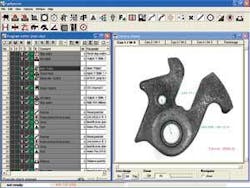Smart cameras get third-party software support
Andrew Wilson, Editor, [email protected]
To broaden the capabilities of smart cameras, several vendors have recently added third-party software support to their product lines. By doing so they allow system integrators to develop machine-vision systems using the software capabilities of PC-based packages embedded within their smart cameras (see Vision Systems Design, Sept. 2006, p. 45).
Continuing this trend, Sirius Advanced Cybernetics (SAC; Karlsruhe, Germany; www.sac-vision.com) and Vision Components (Ettlingen, Germany; www.vision-components.com) have announced a family of smart cameras known as EyeSpector based on SAC’s Coake software and a range of Vision Component’s DSP-based cameras.
(NOTE: SAC no longer supports Eyespector systems - March 2008)
SAC’s Coake uses intuitive icons that can be dragged and dropped into a program editor to build a machine-vision program. Running under Windows 2000, XP, and Vista on PC-based systems, the software includes functions such as image processing and image geometry commands and I/O functions that allow digital I/O functions of smart cameras such as the Eyespector to directly control programmable logic controllers.
At VISION 2006, held in Stuttgart, Tanja Geissler of SAC’s Vision Expert Group gave a demonstration of how these programs could be developed on PC-based systems and then downloaded to EyeSpector 2000, a Vision Components camera with 640 × 480 pixels, 63 frames/s, and an embedded 400-MHz Texas Instruments’ TMS320C64xx processor.
To test the speed of the camera in a lifelike application, Geissler demonstrated how the software could be used to measure two centroids located on a part and measure the distance between them. To obtain the centroid, a “probe points” tool was used to search a threshold located between the inner area of the hole of the part and the outer circumference. By searching between the inner and outer locations, the threshold from white to dark can be used to generate a best fit circle within each hole (see figure). From this best fit circle, the x, y coordinates of the centroid of the part can be determined.
To measure the second centroid point, this code is copied and pasted into the program editor and the search region of the “probe points” tool placed onto this region. A distance tool is used to compute the distance between the centroids using the predetermined centroid coordinates. To determine the time taken to perform this function, a stopwatch function can be inserted at the end of the program.
Once compiled as an .exe file, the program can be run on the PC or downloaded to the EyeSpector 2000 camera. To do this, the program is recompiled to run on Vision Component’s operating system, which runs on the TI DSP. As can be seen, the complete program can be performed in 24 ms on the smart camera (not using image capture).
To achieve higher speeds, system integrators could, of course, choose cameras such as Eyespector 4800, a 640 × 480 camera that uses the faster 1-GHz Texas Instruments TMS320C64xx. According to Geissler, the software can also operate on other smart cameras including the XCI-SX1 from Sony (Park Ridge, NJ, USA; www.sony.com/videocameras) and the Blue Lynx camera series from Matrix Vision (Oppenweiler, Germany; www.matrix-vision.com).

